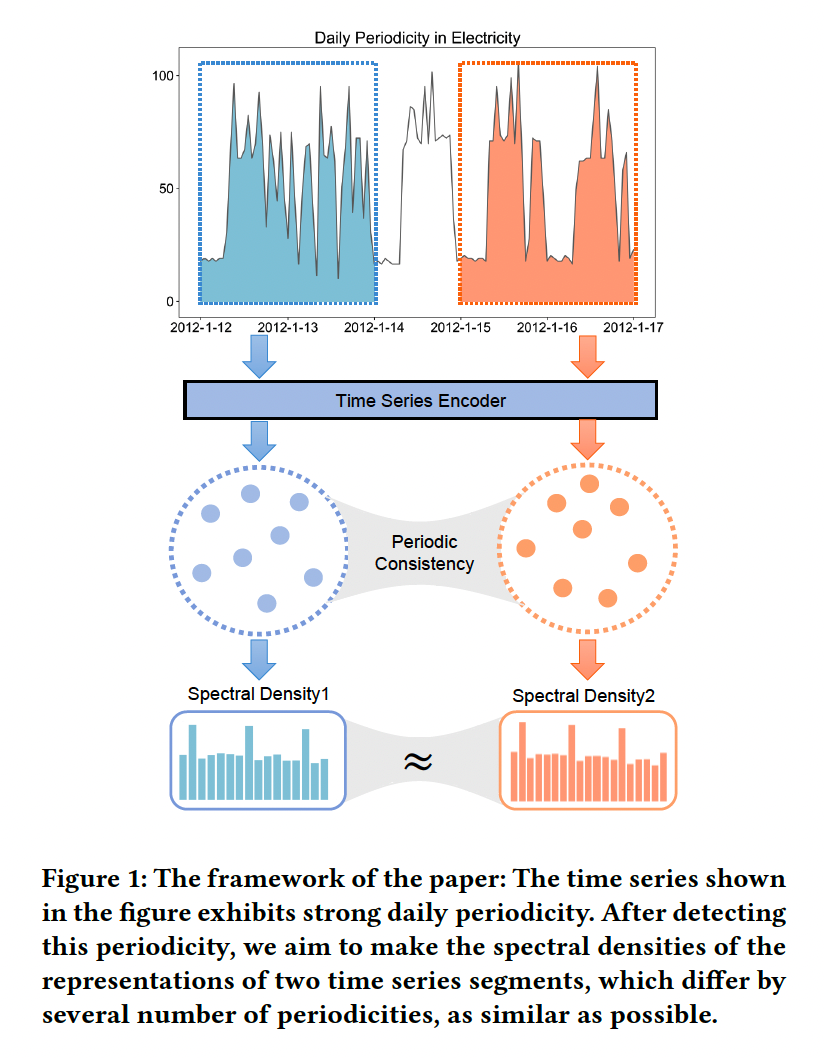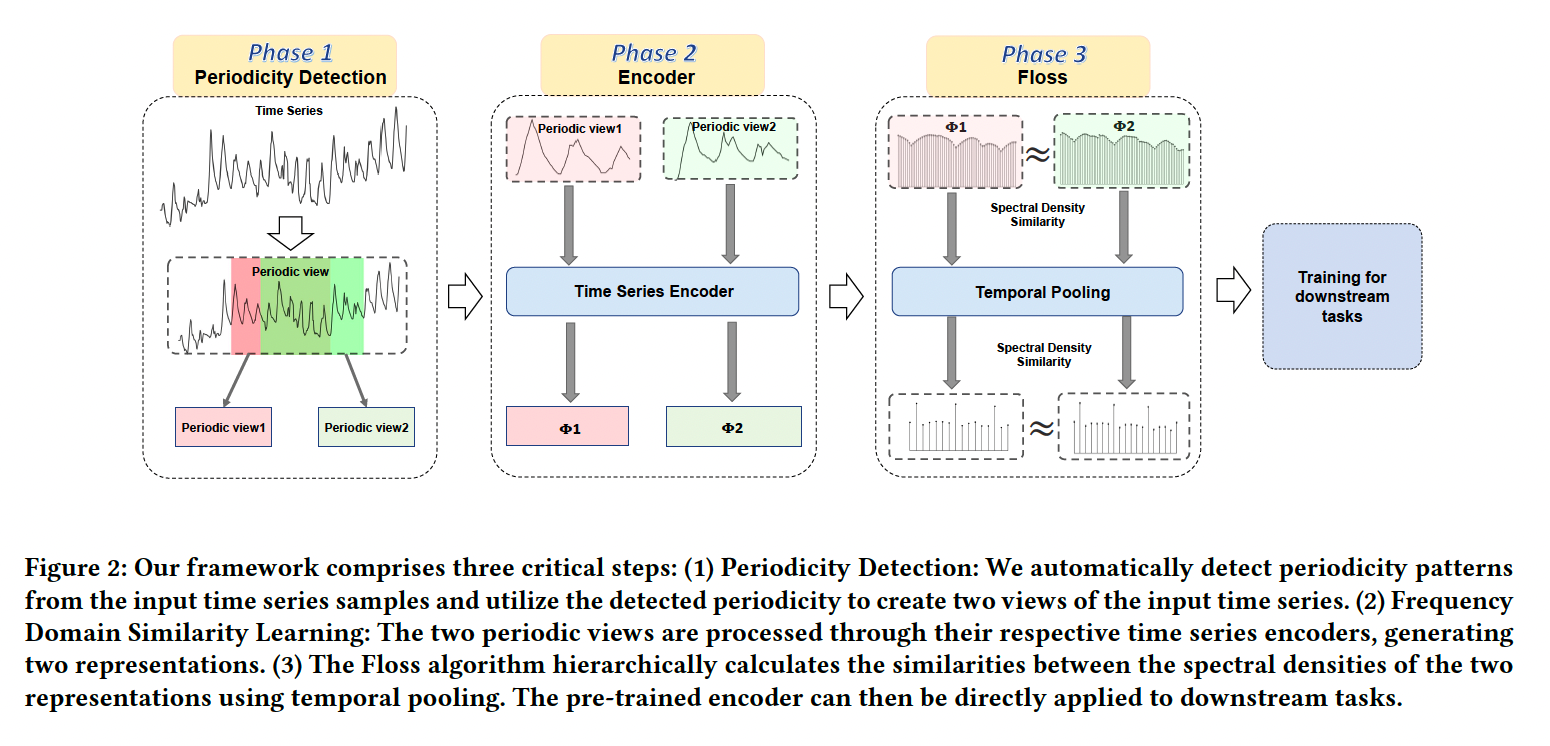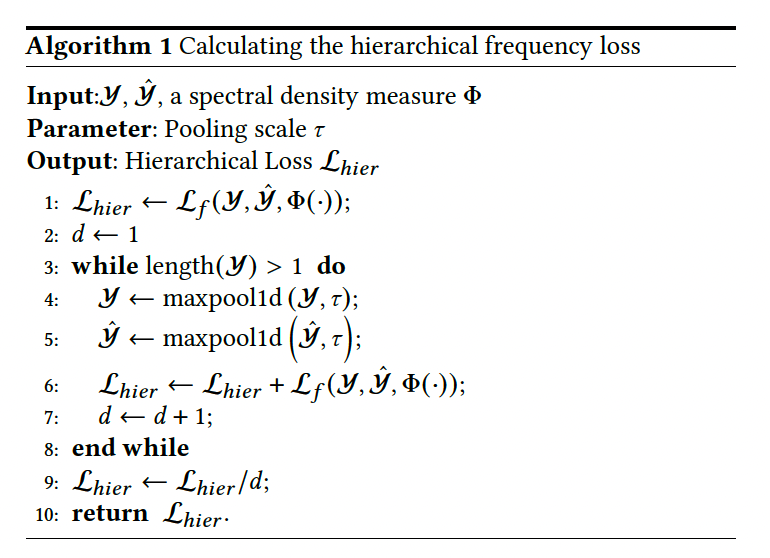Enhancing Represnetation Leanring for Periodic TS with Floss: A Frequency Domain Regularization Approach
Contents
- Abstract
- Introduction
- Preliminaries
- Method
- Periodic Detection & Augmentation
- Hierarchical Frequency-domain Loss
Abstract
TS data exhibit periodicity
Propose an unsupervised method, “Floss”
-
Automatically regularizes representations in the frequency domain
-
Step 1) Automatically detect major periodicity
-
Step 2) Employs periodic shift & spectral densitiy similarity measures
\(\rightarrow\) learn representations with periodic consistency
-
Easily incorporated in to both supervised / semi-supervised / unsupervised learning
1. Introduction
Temporal dynamics of real-world process: have periodicity
Classical approach to detect periodicity
- Employment of frequency domain methods
- ex) discrete Fourier fransform (DFT)
Frequency domain information has been widely leveraged in DL arrchitectures
\(\rightarrow\) Still, none of them are specifically designed to capture periodic cynamics
Floss

- Novel approach that leverages the principles of contrastive learning (CL)
- Floss = simple yet effective combination of loss function & transformation
- (Hypothesis) Spectral density of learned representation remains invariant under periodic transformations
Details
- (1) Frequency domain transformation
- To automatically detect dominant periodicity
- (2) Random periodic shifts
- To create a periodic view of thee target TS in temporal dimension
- (3) Novel task
- Enforces the similarity of spectral densities btw the target TS and its periodicc views
- (4) Hierarchical loss
2. Preliminaries
Notation
- TS: \(\mathcal{X} \in \mathbb{R}^{N \times T \times F}\), \(\mathcal{X}_{\left[t_1, t_2\right]} \in \mathbb{R}^{N \times\left(t_2-t_1+1\right) \times F}\)
- Representation model: \(\mathcal{G}(\cdot ; \theta)\)
- Representation tensor: \(\mathcal{Y}_{\left[t_1, t_2\right]}=\mathcal{G}\left(\chi_{\left[t_1, t_2\right]} ; \theta\right)\).
- \(\mathcal{Y}_{\left[t_1, t_2\right]} \in \mathbb{R}^{N^{\prime} \times\left(t_2-t_1+1\right) \times F^{\prime}}\),
Power Spectral Density
- Provides information about the expected signal power at different frequencies of the signal
- ex) Periodogram
- Measure of spectral density in the Fourier domain
- discrete Fourier transform as \(\mathcal{D} \mathcal{F T}(\cdot)\),
- Periodogram \(\Phi(\cdot)\) :
- \(\begin{gathered} \mathcal{D} \mathcal{F} \mathcal{T}\left(w_j\right)=\frac{1}{\sqrt{n}} \sum_{t=1}^n x_t e^{-2 \pi i w_j t} \\ \Phi\left(w_j\right)=\operatorname{Re}\left(\mathcal{D} \mathcal{F T}\left(w_j\right)\right)^2+\operatorname{Im}\left(\mathcal{D} \mathcal{F} \mathcal{T}\left(w_j\right)\right)^2 \end{gathered}\).
- Other transformations are also OK
- ex) discrete cosine transform (DCT), wavelet transform (DWT)
3. Method
Two key steps
- (1) Periodicity detenction module
- (2) Novel objective
(1) Periodic Detection & Augmentation
Identify underlying periods!
- by calculating the average spectral density
Average spectral density
\(\begin{array}{r} \hat{\Phi}=\frac{1}{N F} \sum_{n=1}^N \sum_{f=1}^F \Phi_{\mathrm{n}, \mathbf{f}}, \\ \hat{w}=\arg \max (\hat{\Phi}), \\ \hat{p}_{\left[t_1, t_2\right]}=\frac{\left(t_2-t_1+1\right)}{\hat{w}} . \end{array}\).
- \(\Phi_{\mathrm{n}, \mathrm{f}}\): Estimated periodogram of the \(f\)-th feature of the \(n\)-th TS
- \(\hat{\Phi} \in \mathbb{R}^{t_2-t_1+1}\) : Average periodogram across features.
- \(j\)-th value \(\Phi\left(w_j\right)\) = Intensity of the frequency- \(j\) periodic basis function
- with the period length \(\frac{\left(t_2-t_1+1\right)}{w_j}\).
- \(j\)-th value \(\Phi\left(w_j\right)\) = Intensity of the frequency- \(j\) periodic basis function
- \(\hat{p}_{\left[t_1, t_2\right]}\) : Maximum periodicity = highest value observed in \(\hat{\Phi}\).
Compute periodogram for each sampled batch
- involves random sampling over time domain during the training period

(2) Hierarchical Frequency-domain Loss
Notation
- \(\boldsymbol{y}=\mathcal{G}\left(x_{\left[t_1, t_2\right]} ; \theta\right)\) and \(\hat{\boldsymbol{y}}=\mathcal{G}\left(x_{\left[\hat{t}_1, \hat{t}_2\right]} ; \theta\right)\).
- Let \(\Phi_y\) and \(\Phi_{\hat{y}}\) : Estimated periodograms of \(\boldsymbol{y}\) and \(\hat{y}\) respectively
Loss function
- \(\mathcal{L}_f=\frac{1}{N^{\prime} F^{\prime}}\mid \mid \Phi y-\Phi_{\hat{y}}\mid \mid _{l 1}\).

